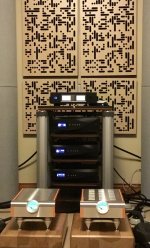- Thread Author
- #1
Anyone hooked up an Aurender W20 to a dCS front end? The documentation is a bit confusing and the Aurender guy I've been corresponding with is trying to help but I'm not convinced we have a plan.
Here is my issue. Currently both the upsampler and the DAC get two inputs each from the dCS master clock: one Group is a multiple of 44.1kHz, the other Group is a multiple of 48kHz. So when a file is sent from the server to the upsampler, Vivaldi senses the resolution and adjusts its clock according. When the upsampler out put is sent to the DAC (presumably at a different resolution) Vivaldi gives it the correct clock frequency also.
The W20 setup as depicted on their website only has one clock signal to the DAC from Group 2 and one clock to the Upsampler from Group 1. The W20 gets its own Group 1 also. So the RS232 control signal from the W20 has to be able to change the Group 1 or Group 2 clock (independently as they may be different) to the DAC and Upsampler so that everyone is synched. Is this how you set up the W20 and how does it work?
Eric
Here is my issue. Currently both the upsampler and the DAC get two inputs each from the dCS master clock: one Group is a multiple of 44.1kHz, the other Group is a multiple of 48kHz. So when a file is sent from the server to the upsampler, Vivaldi senses the resolution and adjusts its clock according. When the upsampler out put is sent to the DAC (presumably at a different resolution) Vivaldi gives it the correct clock frequency also.
The W20 setup as depicted on their website only has one clock signal to the DAC from Group 2 and one clock to the Upsampler from Group 1. The W20 gets its own Group 1 also. So the RS232 control signal from the W20 has to be able to change the Group 1 or Group 2 clock (independently as they may be different) to the DAC and Upsampler so that everyone is synched. Is this how you set up the W20 and how does it work?
Eric

